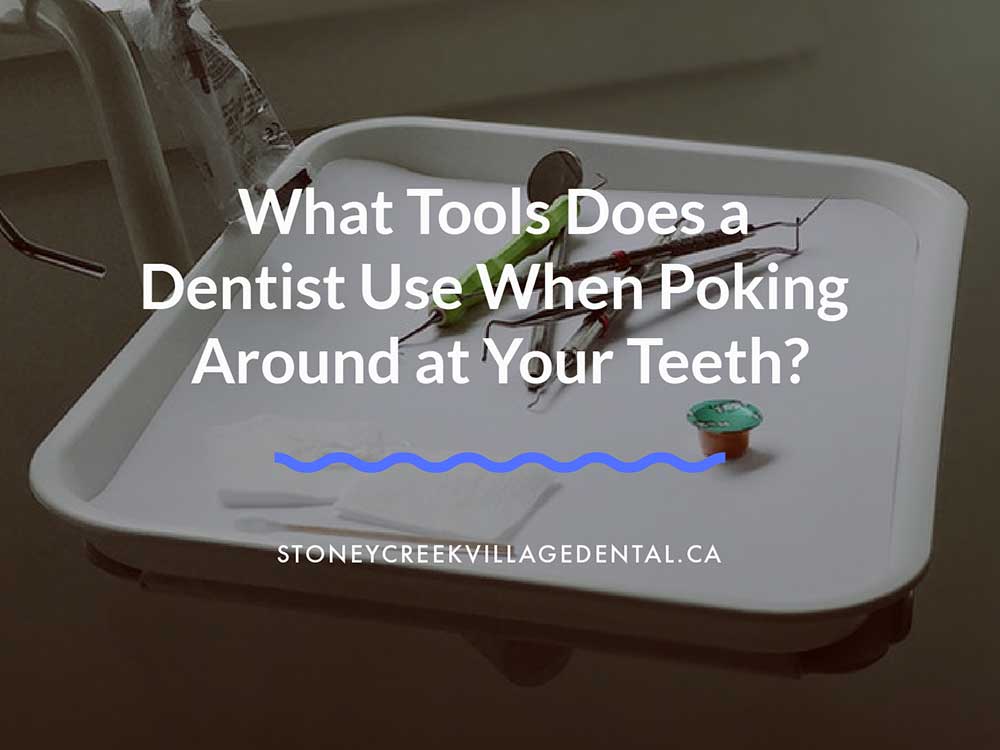
07
Mar
What Tools Does a Dentist Use When Poking Around at Your Teeth?

For some, a trip to the dentist is just another appointment. To others, however, it is a traumatic, though necessary, evil. While we see a share of both kinds of patients, we have an obligation–and sincere desire–to calm the fears that accompany dental anxiety. So we’ve written a quick read about our large array of shiny–and sharp–instruments that sits visibly to the side of the dental chair. We hope by understanding the purpose and how each tool works will make their presence inside the mouth just a little bit more tolerable and less threatening.
Probes
Just like the name suggests, probes are exploration tools, designed to find things. StoneyCreek Village Dental is committed to thorough diagnoses before treatment.
Sickle Probe
Sometimes referred to as a shepherd’s hook, the sickle probe is curved, employed to detect the results of tooth decay. Among its targets are tartar (i.e. hardened plaque, referred to as calculus by professionals), caries (aka cavities) and bone loss.
Periodontal Probe
The periodontal probe is a long, thin device that has a blunt tip. Its mission is to measure the depth of pockets surrounding each tooth. In so doing, it evaluates the condition of the gums.
Mouth Mirror
Even wide open, the mouth is a difficult thing to see from all angles. The tiny mirror at the end of a handle enables the dentist to get a close-up view of every crevice and corner, thereby corroborating visually the tactile impressions of the probes.
Spoon Excavator
This tool’s working end is, in fact, shaped like a spoon. Digging away at soft tooth decay, it allows the dentist to remove it manually without resorting to the drill (more on this below). It can also extract temporary fillings from a tooth.
Dental Syringe and Its Contents
A dentist is sensitive to patient mood and temperament. When a dental syringe comes out, dental anxiety tends to rise. Shortly, however, comes the realization that the contents of the syringe are to numb the gums and teeth so the patient remains comfortable while the dentist works. The numbing agent is called a vasoconstrictor and is accompanied by catalysts like sodium hydroxide and sodium chloride. This local anesthetic is more routine than dental sedation Fort McMurray.
Dental Drill
Dreaded by child and adults alike, the dental drill has a menacing reputation but leaves positive results. Some decay is hard and dense, too difficult for the spoon excavator. Operating at a very high speed, the drill can clean out all of the decay in preparation for a filling. Modern drills can even smooth and polish the affected area. Yes, it sounds noisy and intimidating from the waiting room but it operates with a minimum of disruption to patients well-being.
These are the most common tools found near the Stoney Creek dentist chair. Advanced procedures offer dental sedation when necessary. StoneyCreek Village Dental is committed, not only to good oral health but also to a peaceful and enjoyable experience.
If you’d like to book an appointment, you can call (780) 666-7327 or book now.
Share this Article

Dr. Yohannes Melkie
Dr. Yohannes Melkie obtained his
Biomedical Science degree from the University of Ottawa and his Doctor
of Dental Surgery degree from the University of Western Ontario. After graduation, he moved to Fort Mac,
where he has practiced since.
Dr. Melkie follows various conferences and training sessions to stay current so he can provide the best
quality treatment to his patients. He enjoys collaborating with patients to ensure they get the best
care.
